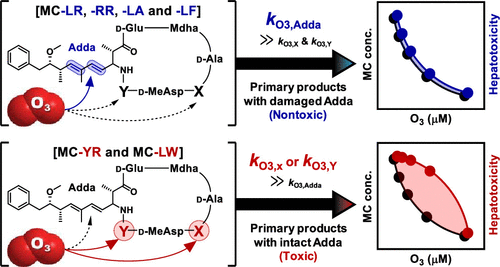Publication
Advanced Redox Technology Lab
Publication
Advanced Redox Technology Lab
Journal papers
The ozonation of six microcystins (MCs) (MC-LR, MC-RR, MC-LA, MC-LF, MC-YR, and MC-LW) was investigated with a focus on the kinetics and decrease in toxicity. Second-order rate constants for the reactions of the six MCs with O3 and •OH (kO3,MC and k•OH,MC) ranged from 7.1 × 105 to 6.1 × 106 M–1 s–1 (kO3,MC) and from 1.2 × 1010 to 1.8 × 1010 M–1 s–1 (k•OH,MC), at pH 7.2 and 20 °C. The activation energies were calculated to be 21.6–34.5 and 11.6–13.1 kJ mol–1 for kO3,MC and k•OH,MC, respectively. The rate constants did not show an important pH dependency, except for kO3,MC-YR, which increased at pH > 7. A kinetic model using the determined rate constants and the measured exposures of O3 and •OH was able to precisely predict the removal of MCs in natural water. The hepatotoxicities of MCs were decreased by ozonation; the toxicities of the four MCs (MC-LR, MC-RR, MC-LA, and MC-LF) decreased nearly concurrently with decreases in their concentrations. However, MC-YR and MC-LW showed a gap between the concentration and toxicity as a result of the incomplete destruction of the Adda moiety (a key amino acid expressing the hepatotoxicity of MCs). A product study using liquid chromatography–mass spectrometry identified a number of oxidation products with an intact Adda moiety produced by the ozonation of MC-YR and MC-LW.
